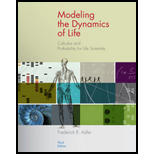
Concept explainers
To find: The long term dynamic in each of the cases and find one that will beat other every time and displays 2:1 AV block and which show some sort of Wenckebach phenomenon.
Answer to Problem 7E
The value of “c” when a little above the threshold value of 0.667 to maintain the equilibrium, the heart, beat 12 times and it builds up to a higher and higher potential. Eventually, the potential is so high that the AV node is not able to recover and the heart fails to beat. As soon as the beat fails the potential drops and the process starts again, this phenomenon is known as the Wenckebach phenomenon.
Explanation of Solution
Given:
The given parameter is,
Calculation:
The potential of the AV node
Then,
For
For
To translate the description into discrete dynamical system we must write
Thus, the two cases is summarized as,
Since
Now setting
The equilibrium exist only if the heart is indeed ready to beat when the next signal comes or if,
Thus, the equilibrium exists only if
Thus, there are two conditions, one is of 2.1 AV block where the heart beats only with every other stimulus and the other is the Wenckebach phenomenon where the heart beats normally for a while and then it skips the beat and then resumes normal beating and repeats cycle.
Consider the potential just after the beating is
If the potential after the two full cycles comes back exactly to where it was started the heart beats with every signal that produces 2:1 AV block.
The expression for the updated potential after the two cycle’s matches the original potential if
Then, the solution is,
The case when the inequalities are satisfied.
As the inequality
Thus, it is not a case of 2:1 AV block.
Compute the condition on c for the existence of the equilibrium.
The equilibrium is,
Then,
Thus, the value of “c” when a little above the threshold value of 0.667 to maintain the equilibrium, the heart, beat 12 times and it builds up to a higher and higher potential. Eventually, the potential is so high that the AV node is not able to recover and the heart fails to beat. As soon as the beat fails the potential drops and the process starts again, this phenomenon is known as the Wenckebach phenomenon.
Want to see more full solutions like this?
Chapter 1 Solutions
Modeling the Dynamics of Life: Calculus and Probability for Life Scientists
- Test data on the bending strength of construction wood poles of various diameter are presented below assuming the same length. Kip- 1000 lbf. Using the following data with 2nd order Newton polynomial interpolation, we want to determine the strength of the material for x=4.3 in. Which data point will be used as x0? After you found x0, enter the value of x-xo in the solution. Answer shall be in one decimal place. Distance (in) Strength (kips) 100 2.7 1 6.8 0.6 5.7 200 300 400 500arrow_forward2/2. prove that if G is Euler then so is L (G).arrow_forwardQ10. What are the chromatic numbers of the following two graphs? G H A. x(G) = 2 and x(H) = 2 B. x(G) = 2 and x(H) = 3 C. x(G) = 3 and x(H) = 2 D. X(G) = 3 and x(H) = 3 E. x(G) = 4 and x(H) = 3arrow_forward
- Q/prove that:- An edge only if e e of agraph G is abridge if and is not part of any cycle in G.arrow_forwardQ/ Give an Such that L(G) example of a simple graph G is Euler but G is not.arrow_forwardAttempted the problem with different numbers but got a row of zeros and does not match the answer provided; even with the free variables. I dont know what I'm doing wrongarrow_forward
- Let G be a graph with the following properties: G is simple, connected and planar. Every vertex of G has a degree of 4. Every face of G has three edges and every edge of G belongs to two faces. Does such a graph exist? If so, how many vertices, edges and faces does it have? (Hint: Turn each of the above property into an equation about the number of vertices, edges and/or faces of the graph.)arrow_forwardYou are provided with data that includes all 50 states of the United States. Your task is to draw a sample of: o 20 States using Random Sampling (2 points: 1 for random number generation; 1 for random sample) o 10 States using Systematic Sampling (4 points: 1 for random numbers generation; 1 for random sample different from the previous answer; 1 for correct K value calculation table; 1 for correct sample drawn by using systematic sampling) (For systematic sampling, do not use the original data directly. Instead, first randomize the data, and then use the randomized dataset to draw your sample. Furthermore, do not use the random list previously generated, instead, generate a new random sample for this part. For more details, please see the snapshot provided at the end.) Upload a Microsoft Excel file with two separate sheets. One sheet provides random sampling while the other provides systematic sampling. Excel snapshots that can help you in organizing columns are provided on the next…arrow_forwardThe University of the West Indies Open Campus ECON2016 Mathematical Methods of Economics II Final Assessment Instructions: Answer ALL the questions. Show all working 1. Solve the following Differential Equations a) dy = x²-1; y(-1) = 1 dx y²+1 dy b) d x + 2y = 3; dx c) dy-4y = 4y² dt d) 6dzy dx² dy -5+ y = 0; y(0) = 4 y'(0) = 0 dx [6] [5] [5] [6]arrow_forward
 Big Ideas Math A Bridge To Success Algebra 1: Stu...AlgebraISBN:9781680331141Author:HOUGHTON MIFFLIN HARCOURTPublisher:Houghton Mifflin HarcourtAlgebra & Trigonometry with Analytic GeometryAlgebraISBN:9781133382119Author:SwokowskiPublisher:Cengage
Big Ideas Math A Bridge To Success Algebra 1: Stu...AlgebraISBN:9781680331141Author:HOUGHTON MIFFLIN HARCOURTPublisher:Houghton Mifflin HarcourtAlgebra & Trigonometry with Analytic GeometryAlgebraISBN:9781133382119Author:SwokowskiPublisher:Cengage

